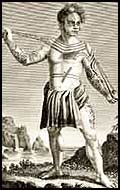Jean Baptiste Cabri
In 1804, Jean Baptiste Cabri was discovered by George H. von Langsdorff, a Russian explorer, while the latter was visiting the Marquesas. Cabri was a French deserter who had been living in the Marquesas Islands for some years and had not only been extensively tattooed, but also had taken a wife.
Returning first to Russia, Cabri enjoyed some success exhibiting himself and telling tales of his life with the 'savage people' of the islands. He not only exhibited himself in Russia but also toured Europe. However, his career declined quickly and he died in 1812 (or 1818 according to some sources) with little remaining fame.
Cabri is most notable as one the first successful extensively tattooed Europeans to exhibit himself. Prior to Cabri, tattooed exhibitions were primarily native people (like Giolo and Omai) or sailors who returned with only small token tattoos received while on expedition. He also set the standard for the 'civilized' tattooed exhibition act by telling exaggerated and aggrandized stories of his capture and subsequent tattooing. Cabri would be followed by men like John Rutherford and Constantine.
